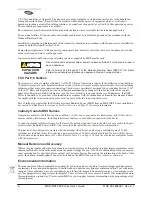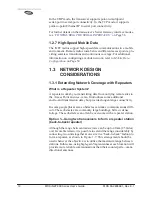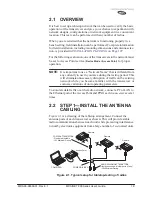
MDS 05-2806A01, Rev. E.1
MDS iNET 900 Series User’s Guide
13
The Access Points are unaware of the existence of the other AP’s.
Because the hopping algorithm uses both the Network Name and the
Wireless MAC address of the AP to generate the hopping pattern, mul-
tiple AP’s can coexist—even if they use the same network name. The
collocated AP’s will be using different hopping patterns and frequencies
the great majority of the time. Although some data collisions will occur,
the wireless-MAC is built to tolerate and recover from such occurrences
with minimal degradation.
1.3.3 Collocating Multiple Radio Networks
Many networks can operate in relatively close physical proximity to one
another provided reasonable measures are taken to assure the radio
signal of one Access Point is not directed at the antenna of the second
Access Point.
The Network Name and the association process
The Network Name is the foundation for building individual radio net-
works. It is part of a beacon signal broadcast by the Access Point (AP)
to any Remote units with the same Network Name. Remotes that join the
network are referred to as being “associated” with the Access Point unit.
Multiple APs with the same Network Name should be avoided unless a
redundant system is being deployed. Using the same Network Name in
multiple APs may result in Remotes associating with undesired APs and
preventing data exchange from occurring.
The use of a different Network Name does not guarantee an interfer-
ence-free system. It does however, assure that only data destined for a
unique network is passed through to that network.
Co-Location for
Multiple Networks
It may be desirable to co-locate Access Points at one location to take
advantage of an excellent or premium location that can serve two inde-
pendent networks. Each network should have unique Network Name
and each AP unit’s antenna should be provided as much vertical separa-
tion as is practical to minimize RFI.
NOTE:
All transceivers are shipped with the Network Name set to
“Not Programmed.” The Network Name must be programmed
in order to pass data and begin normal operations.
Can radio frequency interference (RFI) disrupt my wireless
network?
When multiple radio networks operate in close physical proximity to
other wireless networks, individual units may not operate reliably under
weak signal conditions and may be influenced by strong radio signals in
adjacent bands. This radio frequency interference cannot be predicted
with certainty, and can only be determined by experimentation. If you
need to co-locate two units, start by using the largest possible vertical
Содержание iNET 900 Series
Страница 10: ...2 MDS iNET 900 Series User s Guide MDS 05 2806A01 Rev E 1 ...
Страница 26: ...18 MDS iNET 900 Series User s Guide MDS 05 2806A01 Rev E 1 ...
Страница 118: ...110 MDS iNET 900 Series User s Guide MDS 05 2806A01 Rev E 1 ...
Страница 120: ...112 MDS iNET 900 Series User s Guide MDS 05 2806A01 Rev E 1 ...
Страница 136: ...128 MDS iNET 900 Series User s Guide MDS 05 2806A01 Rev E 1 ...
Страница 148: ...140 MDS iNET 900 Series User s Guide MDS 05 2806A01 Rev E 1 ...
Страница 150: ...142 MDS iNET 900 Series User s Guide MDS 05 2806A01 Rev E 1 ...
Страница 164: ...156 MDS iNET 900 Series User s Guide MDS 05 2806A01 Rev E 1 ...
Страница 172: ...164 MDS iNET 900 Series User s Guide MDS 05 2806A01 Rev E 1 ...
















































